
Nissan Qashqai 2020 review
The Nissan Qashqai is hugely popular, and the 2020 update has made a good car better - but there's something you should know before you buy and it might make you wait.
Browse over 9,000 car reviews
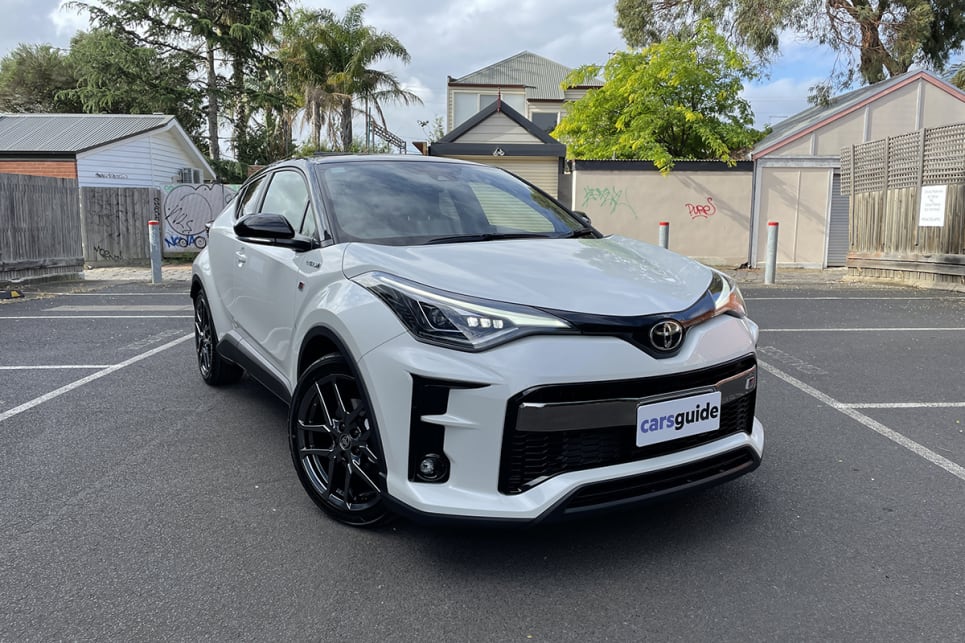
Toyota’s emerging GR (Gazoo Racing) performance sub-brand is off to a hot start in Australia, with the GR Supra sports car making waves on debut late last year, while the GR Yaris hot hatch has been met with unprecedented demand ahead of its launch.
So, where to next? Well, the GR treatment will of course spread to other models in Toyota Australia’s line-up, with the C-HR small SUV now offering Australia's first taste of the performance sub-brand’s entry-level tier, GR Sport.
Much like BMW M’s M Sport, Audi Sport’s S Line and Mercedes-AMG’s AMG Line – or even Hyundai N’s N Line in more recent times – GR Sport makes regular versions of Toyota models a little sportier with a visual package and a minor mechanical tweak.
But with the C-HR GR Sport so far only available in Australia with a hybrid powertrain, can it really be considered sporty and therefore worthy of the new badge? As always, there’s only one way to find out: we’ve got to put it to test. Read on.
| Toyota C-HR 2021: GR-S (2WD) TWO Tone Hybrid | |
|---|---|
| Safety rating | |
| Engine Type | 1.8L |
| Fuel Type | Hybrid with Regular Unleaded |
| Fuel Efficiency | 4.3L/100km |
| Seating | 5 seats |
| Price from | $39,930 |
The C-HR already has a pretty arresting design that you’ll either love or hate, so it’s hard to imagine how much further the GR Sport version can push the envelope. As it turns out, it does it just enough.

Specifically, the GR Sport stands out from the C-HR crowd with its more aggressive front fascia, which consists of unique versions of the bumper, grille and LED headlights. We’d go as far as to say makes the small SUV seriously good looking – in an edgy, sporty way.

Meanwhile, around the side, the GR Sport gets a unique set of (very shiny) dark-chrome 19-inch alloy wheels with 225/45 Yokohama Advan Fleva tyres.
And other than those four exterior features and ‘GR Sport’ badging on all four sides, the GR Sport is no different to look at than other C-HR variants, which is a good thing if you were already a fan like us.
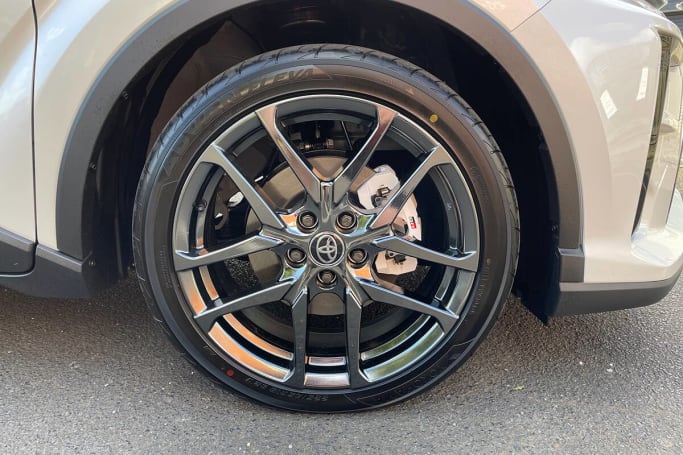
Inside, aside from black leather/suede upholstery with white accents and stitching, the GR Sport gets the obligatory (and supportive) front sports seats with ‘GR’ badging, a sportier gear selector and aluminium pedals … and that’s about it; it’s a C-HR by any other name.
This is a shame because further differentiation is available in Japan, where the GR Sport is fitted with a sports steering wheel with a ‘GR’ logo, another of which appears on the local tachometer. While minor, these touches would’ve made for something even more special.


Measuring 4395mm long, 1795mm wide and 1550mm tall with a 2640mm wheelbase, the C-HR is slightly on the larger side for a small SUV, which is - theoretically - great for practicality.

That said, cargo capacity is subpar, at 318L (VDA), but it can be increased to an undisclosed volume by stowing the 60/40 split-fold rear bench, an action that can easily be performed by reaching the necessary manual releases from the boot.
The boot is more useful than the data above suggests, with a nicely shaped aperture teaming with a small load lip in the name of convenience when loading or unloading bulkier items. Then there are the four tie-down points and two bag hooks, which ensure the boot is truly versatile. Again, judge it on paper at your own peril.
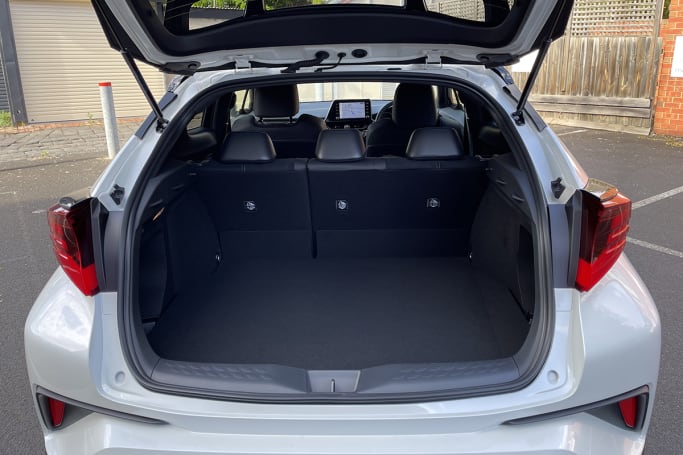
However, things take a step backwards in the second row, where directional air vents, connectivity options and a fold-down central armrest are noticeably (and inexplicably) absent.
Rear door bins aren’t present, either, although the side armrests do have one integrated cupholder each, so at least bottles aren’t completely neglected. And there are map pockets affixed to the back of the front seats.
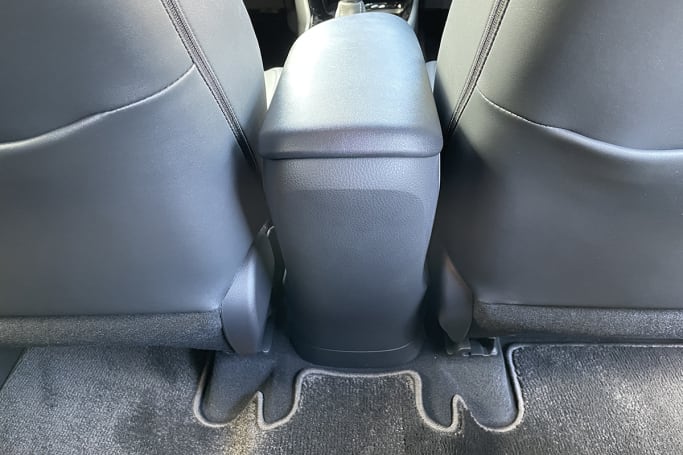
Nonetheless, rear occupants sit in relative comfort, with approximately three inches of legroom available behind my own 184cm driving position alongside an inch of headroom.
Two adults can share the second row without question, but add a third into the equation and discomfort will soon follow, even though the transmission tunnel is small. Needless to say, make it a shorter journey. Conversely, children will be happy either way - though the windowline might have some wishing for a better view.
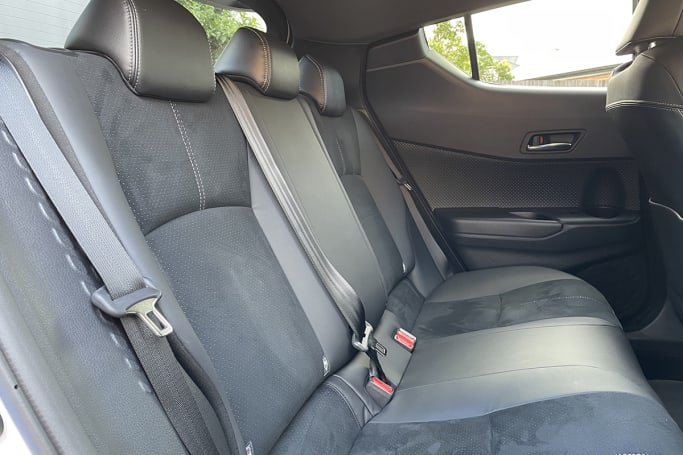
And while we’re on the topic, two ISOFIX and three top-tether anchorage points are part of the rear bench, with child seats able to be fitted, but just don’t expect much leftover space if you need to fit a pair.
In the first row, occupants have to share the single USB-A port available, which is located at the bottom of the centre stack, right next to a slot-like cubby.
Meanwhile, a 12V power outlet is hidden in the central storage bin, which is on the larger side. The glovebox is another decent in-cabin storage option.
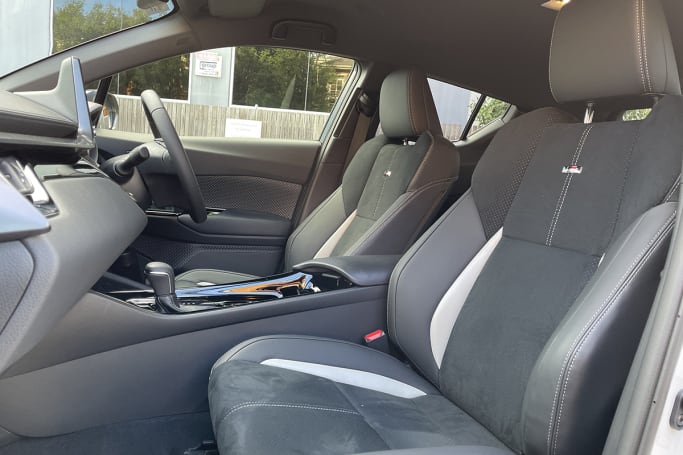
While actually present, the front door bins are quite slim, meaning they can only take on regular bottle each – at a pinch. Alternatively, there are the centre console’s two cupholders, which are actually positioned either side of the gear selector.
Priced from $37,665 plus on-road costs, the GR Sport (hybrid only) sits alongside the other C-HR flagship grade, the Koba (petrol and hybrid), and above the entry-level GXL (petrol only).
Considering it costs the same as its Koba equivalent, the GR Sport represents a simple – and reasonably priced – choice between something sportier and something more luxurious.

The unique kit in the GR Sport has already been mentioned above, but it naturally comes on top of what the GXL offers, which includes dusk-sensing lights, LED daytime running lights and fog-lights, rain-sensing wipers, power-folding side mirrors with heating, and a space-saver spare wheel.
Inside features include an 8.0-inch touchscreen multimedia system, satellite navigation with live traffic, Apple CarPlay and Android Auto support, Bluetooth connectivity, a six-speaker sound system, a 4.2-inch multifunction display, keyless entry and start (a new inclusion for MY21), dual-zone climate control and an auto-dimming rearview mirror.
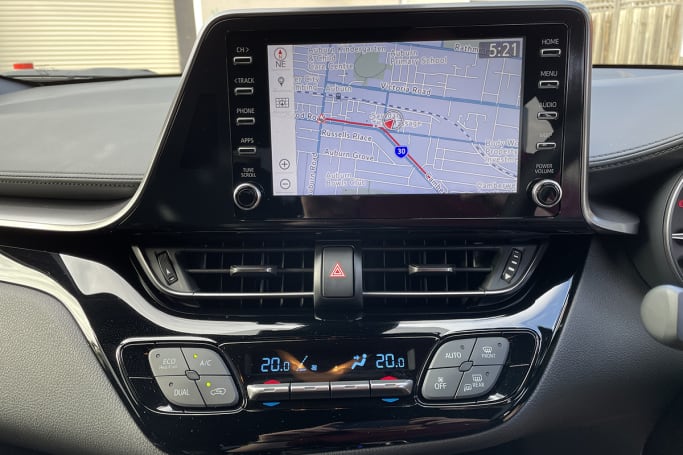
For reference, the Koba separates itself with 18-inch alloy wheels, rear privacy glass, heated front seats and leather-accented upholstery.
Eight colours are available for the GR Sport, three of which are two-tone colourways: Crystal Pearl, Hornet Yellow or Feverish Red with a black roof. Our test vehicle was finished in the former, a $450 option.
The GR Sport currently has one rival: the Subaru XV Hybrid ($35,490 to $40,790 plus on-road costs), although the Mitsubishi Eclipse Cross PHEV and Nissan Qashqai e-Power will enter the fray next year, providing more low-emissions competition in the segment.
The GR Sport’s ‘self-charging’ hybrid powertrain combines a 1.8-litre naturally aspirated four-cylinder petrol engine (running on the Atkinson cycle) with two electric motors for a combined power output of 90kW. Yep, don’t let its name fool you, it isn’t a powerhouse.
This set-up drives the front wheels only via an electronic continuously variable automatic transmission (e-CVT) with seven simulated steps. Unlike the new Yaris Cross light SUV, all-wheel drive is not an option, which is unfortunate on paper but no great loss in reality.
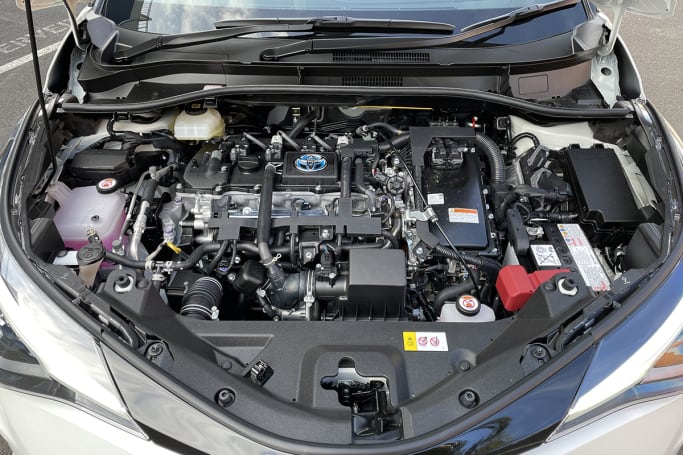
The GR Sport’s fuel consumption on the combined-cycle test (ADR 81/02) is exceptionally good, at 4.3L per 100km, while its carbon dioxide (CO2) emissions are 97g per km.
While we only had the GR Sport on test for two days, over 160km of driving split evenly between city streets and highways, the trip computer reported an average of 4.5L/100km, which is a stellar real-world result.
For reference, the GR Sport’s 43L fuel tank can be filled up with 91RON petrol at minimum.
ANCAP awarded the C-HR its maximum five-star safety rating in 2017, with it applying to all of the small SUV’s variants. Yep, it even covers the new GR Sport.
Advanced driver-assist systems in the GR Sport extend to all-speed adaptive cruise control, road sign recognition, blind-spot monitoring, rear cross-traffic alert (an active version is now available in the Koba), high-beam assist, a reversing camera (the Koba gets surround-view cameras), front and rear parking sensors, and hill-start assist.
Of note, the C-HR’s suite recently expanded to include an autonomous emergency braking (AEB) system that has intersection assist and detects cyclists (day) in addition to pedestrians and other vehicles (day and night).
Meanwhile, steering and emergency assist joined lane departure warning and lane-keep assist as part of the C-HR’s lane support system (LSS) package.
Other standard safety equipment in the GR Sport includes stability and traction control, anti-skid brakes (ABS), electronic brakeforce distribution (EBD) and brake assist (BA) plus seven airbags. Needless to say, there’s very little missing here.
Basic Warranty
5 years / unlimited km warranty
ANCAP Safety Rating

As with all Toyota Australia models, the C-HR comes with a five-year/unlimited-kilometre warranty, which is average in this market, though Toyota does back its powertrains with seven years warranty if you keep logbook maintenance records. There's up to 10 years of coverage available for the GR Sport’s hybrid battery.
Service intervals are also average, at every 12 months or 15,000km (whichever comes first), but cost just $200 for each of the first four visits as part of a capped-price servicing plan, for a total of $800 for the first 48 months or 60,000km of ownership. That is very competitive.
When it comes to the GR Sport and what it’s like to drive, there are just two things you need to know: it has sports suspension and larger-diameter alloy wheels with lower-profile tyres.
Yep, before you even get behind the wheel, you already know the GR Sport will be the best-handling but poorest-riding C-HR variant, but the question is to what degree? As it turns out, the real-world differences are almost negligible.
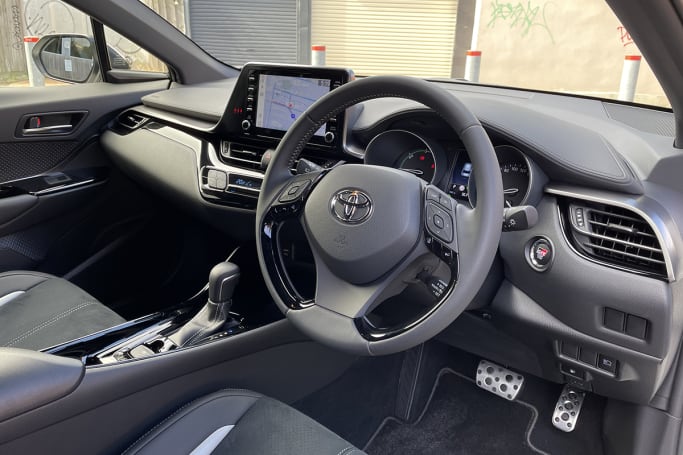
Firstly, it’s worth noting you get the same MacPherson-strut front and double-wishbone rear suspension as the other C-HR variants, but it’s been lowered by 15mm and stiffened (shock absorber damping force, coil-spring rates and stabiliser bars) in keeping with the GR Sport ethos.
Drive away and it’s not immediately noticeable what you’re dealing with, but catch a sharp edge of a lower-quality road and it becomes apparent a trade-off has been made in the name of not only handling, but also style.
Needless to say, potholes and speed bumps also expose the GR Sport’s poorer ride, while undulations really bring it to the fore, showing just how much jitterier things can get.
That’s not to say the GR Sport has a poor ride, because it really doesn’t. In fact, we’d say it’s more than liveable around town, where the compromises it makes really aren’t all that noticeable. That said, it’s not the best C-HR variant to live with.
But before we go on, we should mention electronic power steering is also on hand, and it's been ever so slightly retuned (centre brace) to earn the sports moniker, so it largely performs as expected, which is a really good thing because it’s well-weighted and rather direct while offering solid feedback.
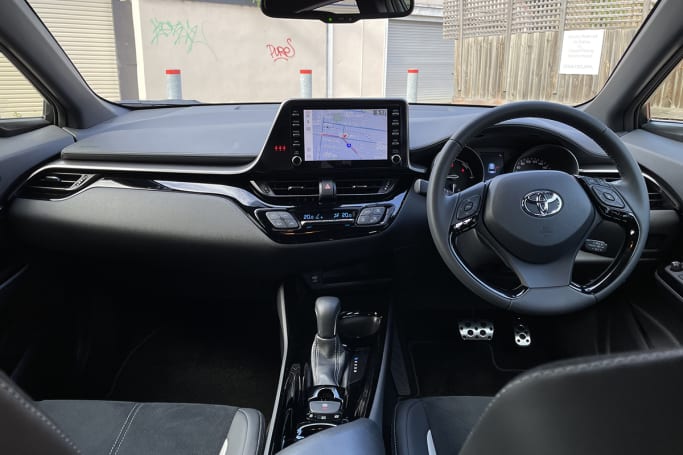
In combination, all of this means the GR Sport puts in an arguably class-leading effort when it comes to handling, just like the C-HR’s regular variants do – but marginally better.
Body control is one of the GR Sport’s strong suits, with it ready and willing to be tipped into a corner with intent. As a result, the driver is also filled with confidence when attacking the twisty stuff.
And despite the lack of all-wheel drive, the GR Sport never feels short of grip, but that may have more to do with the fact that it’s a low-powered small SUV at the end of the day.
Speaking of which, while the GR Sport’s powertrain sips petrol like its top-shelf scotch, the obvious shortcoming here is how achingly slow it is to accelerate, even when petrol and electric power are being delivered simultaneously.

This not a vehicle that wants to be driven hard, so don’t let the name deceive you; there’s nothing remotely sporty about the GR Sport’s seamless hybrid system. In fact, it actively encourages the driver to give their right foot a rest.
Yep, a gentler driving style is not only more relaxing, but it also delivers superior economy. Now, that doesn’t exactly sound like something you’d expected from a vehicle called GR Sport, does it?
We’d say a better option for the GR Sport would’ve been the 85kW/185Nm 1.2-litre turbo-petrol three-cylinder engine that’s available in other C-HR variants. While it wouldn’t be a massive improvement, it would be closer to the brief, not to mention theoretically $2500 cheaper.
It would be unfair of us to suggest the GR Sport is all show and no go, because the C-HR foundations it builds upon are rock solid when it comes to ride and handling, such is the brilliance of Toyota’s TNGA platform.
And in isolation, the GR Sport is truly a great small SUV, but take into account the wider C-HR range and it’s apparent there are better, more sensible options out there when it comes to the overall package.
That said, if you want to stand out from the crowd (and regular C-HR variants already do), the GR Sport is certainly one way to do it. Just don’t expect its straight-line performance to be worthy of the nameplate.
| Vehicle | Specs | Price* | |
|---|---|---|---|
| GXL (awd) | 1.2L, PULP, CVT AUTO | $33,220 – 39,490 | 2021 Toyota C-HR 2021 GXL (awd) Pricing and Specs |
| GR-S (2WD) Hybrid | 1.8L, Hyb/ULP, CVT AUTO | $39,490 – 46,420 | 2021 Toyota C-HR 2021 GR-S (2WD) Hybrid Pricing and Specs |
| GXL (2WD) | 1.2L, PULP, CVT AUTO | $31,570 – 38,060 | 2021 Toyota C-HR 2021 GXL (2WD) Pricing and Specs |
| GR-S (2WD) TWO Tone Hybrid | 1.8L, Hyb/ULP, CVT AUTO | $39,930 – 46,970 | 2021 Toyota C-HR 2021 GR-S (2WD) TWO Tone Hybrid Pricing and Specs |
| Design | 8 |
|---|---|
| Practicality | 7 |
| Price and features | 7 |
| Under the bonnet | 7 |
| Efficiency | 9 |
| Safety | 8 |
| Ownership | 9 |
| Driving | 8 |
$28,800
Lowest price, based on 141 car listings in the last 6 months